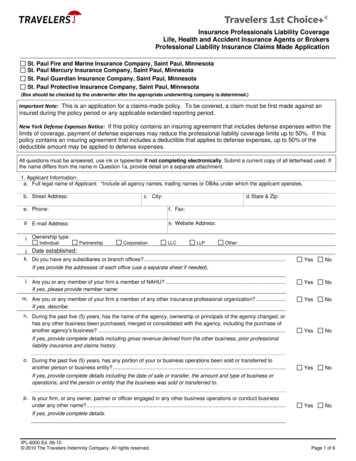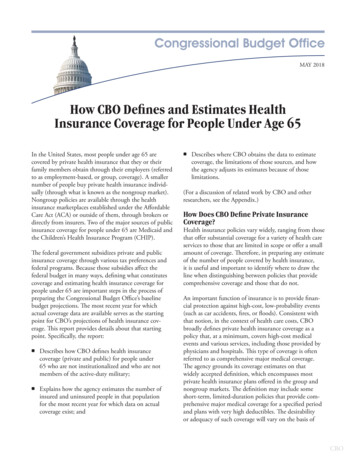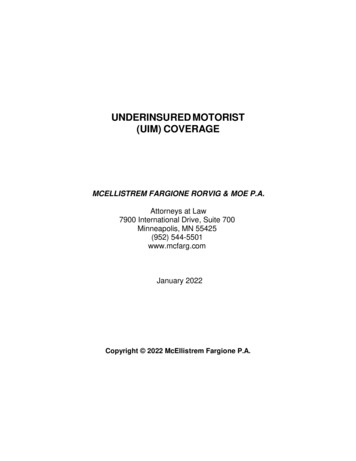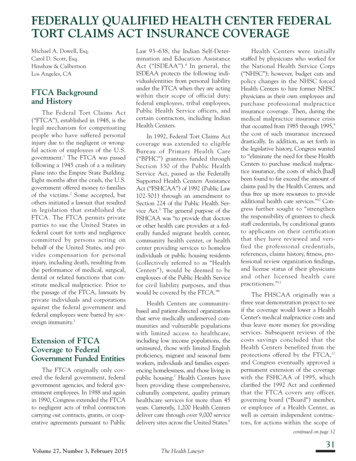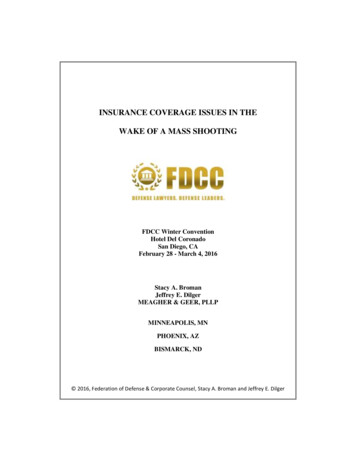
Transcription
INSURANCE COVERAGE ISSUES IN THEWAKE OF A MASS SHOOTINGFDCC Winter ConventionHotel Del CoronadoSan Diego, CAFebruary 28 - March 4, 2016Stacy A. BromanJeffrey E. DilgerMEAGHER & GEER, PLLPMINNEAPOLIS, MNPHOENIX, AZBISMARCK, ND 2016, Federation of Defense & Corporate Counsel, Stacy A. Broman and Jeffrey E. Dilger
Stacy A. BromanStacy Broman is a Senior Partner with the law firm of Meagher & Geer, P.L.L.P.with offices in Minneapolis, Minnesota, Phoenix, Arizona and Bismarck, North Dakota.She is a member of the firm’s Management Committee.Stacy Broman focuses her practice on complex commercial litigation defendinginsurers in insurance coverage and bad faith litigation, and she represents professionals inprofessional liability litigation. For her work on behalf of the insurance industry, she wasnamed by Best Lawyers as Minneapolis Insurance Lawyer of the Year for 2013. She islisted in The Best Service Professionals in the United States (under Lawyers: Insurance)and in The Best Lawyers in America . She was selected as a 2014 Top-Rated Lawyer inInsurance Law by the American Lawyer and Corporate Counsel magazines, andMartindale – Hubbell. She has been included in the Minnesota Super Lawyers list 2005 2014.Stacy is an active member of the Federation of Defense & Corporate Counsel andwas elected to its Board of Directors in 2014. She has held the following positions: Board of Directors (2014 - Present)Chair, Amicus and Public Policy Committee (2013 - Present)Chair, Extra Contractual Liability Section (2012 - 2014)Chair, Appellate Section (2010 - 2012)Vice Chair, FDCC Deposition Boot Camp (2014 - Present)Vice Chair, Amicus Committee (2008 - 2013)Vice Chair, Insurance Coverage Section (2006 - 2012)Vice Chair, Extra-Contractual Liability Section (2006 - 2012)Member, Admissions Committee (2011 - Present)Member, Foundation Fundraising Committee (2014 - Present)Member, Membership Development and Retention Committee (2005 - 2011,2013 - 2014)Member, Ad Hoc Special Assessment Committee (2012 - 2013)Member, Nominating Committee (2009 - 2010)Member, Resolutions Revisions Committee (2009 - 2010)Fellow, Litigation Counsel of America (A trial lawyer honorary society, withmembership limited to one-half of one percent of American lawyers, and byinvitation only)Charter Member, Diversity Law Institute, Member, Advisory Board (20142015)Founder, Insurance Institute of America (ILIA) of the Litigation Counsel ofAmerica (founded 2013)Stacy was also elected to the American College of Coverage andExtracontractual Counsel in 2013 and is a member of the Board of Directors.-i-
Outside the office, Stacy volunteers her time with the Southern MinnesotaRegional Legal Services as a member of The Campaign for Legal Aid. She is a frequentlecturer and author on issues affecting the insurance industry.Jeffrey E. DilgerJeffrey E. Dilger obtained his undergraduate degree from the University ofMinnesota in 2005. After graduation, he worked as a private investigator for three yearsbefore entering law school. In 2011, he graduated magna cum laude from the Universityof Minnesota Law School and immediately began practice as a civil litigator.- ii -
INSURANCE COVERAGE ISSUES IN THEWAKE OF A MASS SHOOTINGFollowing the tragedy in Aurora, as it was with Newtown, as it waswith Virginia Tech, and as it has been at so many sites of mass shootings,investigation of the circumstances of mass shooting events gave rise tolawsuits seeking recovery for losses sustained at the hands of a mentallyunstable criminal. These suits have traditionally alleged liability amongtwo types of entities: (1) the supplier of weapons, ammunition, and gear,both personally and corporately; and (2) the owner of the premises at whichthe mass shooting took place. While Congress has largely immunized thecorporate suppliers of weaponry, ammunition, and gear;1 premise ownersare without similar protections. Given the very real potential for premisesliability, this paper seeks to explore some of the basic issues related toinsurance coverage for premise owners in the wake of a mass shooting.I.FACTS.July 20, 2012 marked the nationwide release date of The DarkKnight Rises. To capitalize on the anticipated demand, the Century Aurora16—like many theaters across the country—opted to show the movie assoon as able, at midnight.Investigation following the incident revealed that shortly beforemidnight on July 20, 2012 a mentally unstable James Holmes drove to thetheater, entered the theater through the front door, presented the ticket hehad purchased 12 days earlier, and waited for the movie to start. Sometimebetween 12:20 and 12:30 a.m., Mr. Holmes exited the theater throughtheater 9’s emergency exit, propped the door open with a piece of plastic,went to his car, donned protective armor, armed himself, and then reentered the theater through the propped open emergency exit atapproximately 12:38 a.m. Several minutes and 76 shots later, 70 peoplewere either injured or dead as a result of gunshot wounds with 12 moreinjured from other causes.1See, e.g., Protection of Lawful Commerce in Arms Act, 15 U.S.C. §§ 7901-7903.INSURANCE COVERAGE ISSUES IN THEWAKE OF A MASS SHOOTING-1-
In the wake of the shooting, lawyers for the plaintiffs have allegedthat Cinemark was negligent, in part, for the following reasons:1.2.3.4.5.Cinemark had information that previous disturbances,incidents disruptions and other criminal activities hadtaken place at or near the theater;Cinemark had previously hired security personnel forevents at the theater, but did not do so for the midnightpremier on July 20, 2012;The exterior doors to the theater were lacking anyalarm system, interlocking security systems, or anyother security alarm features which would have putCinemark on notice that the door had been proppedopen;Cinemark failed to have security practices orprocedures in place; nor did it employ or adequatelytrain any employees or security personnel to prevent ordeter someone from unlawfully re-entering the theater;Cinemark did not have a system for monitoring theparking areas and external doors;See, e.g., Complaint, Traynom et al. v. Cinemark, USA, Inc. d/b/a CenturyAurora 16, 12-CV-02514, ECF Doc. 1, September 21, 2012 (D. Colo.).II.DO MASS SHOOTINGS TRIGGER A CGL POLICY?As with all coverage analyses, the first issue is whether the loss fallswithin the insuring agreement of the insurance policy. To assist in thatanalysis, this paper primarily analyzes the coverage issues from thestandpoint of typical forms and language found in modern ISO CommercialGeneral Liability Insurance Forms. The standard CGL insuring agreement,in relevant part, reads:SECTION I – COVERAGESCOVERAGE A – BODILY INJURY AND PROPERTYDAMAGE LIABILITYINSURANCE COVERAGE ISSUES IN THEWAKE OF A MASS SHOOTING-2-
1. Insuring Agreementa. We will pay those sums that the insured becomes legallyobligated to pay as damages because of “bodily injury” or“property damage” to which this insurance applies. We willhave the right and duty to defend the insured against any“suit” seeking those damages. However, we will have no dutyto defend the insured against any “suit” seeking damages for“bodily injury” or “property damage” to which this insurancedoes not apply. We may, at our discretion, investigate any“occurrence” and settle any claim or “suit” that may result.But:(1) The amount we will pay for damages is limited asdescribed in Section III – Limits Of Insurance; and(2) Our right and duty to defend ends when we have used upthe applicable limit of insurance in the payment of judgmentsor settlements under Coverages A or B or medical expensesunder Coverage C.No other obligation or liability to pay sums or perform acts orservices is covered unless explicitly provided for underSupplementary Payments – Coverages A and B.b. This insurance applies to “bodily injury” and “propertydamage” only if:(1) The “bodily injury” or “property damage” is caused by an“occurrence” that takes place in the “coverage territory”;(2) The “bodily injury” or “property damage” occurs duringthe policy period; and(3) Prior to the policy period, no insured listed underParagraph 1. of Section II – Who Is An Insured and no“employee” authorized by you to give or receive notice of an“occurrence” or claim, knew that the “bodily injury” orINSURANCE COVERAGE ISSUES IN THEWAKE OF A MASS SHOOTING-3-
“property damage” had occurred, in whole or in part. If such alisted insured or authorized “employee” knew, prior to thepolicy period, that the “bodily injury” or “property damage”occurred, then any continuation, change or resumption ofsuch “bodily injury” or “property damage” during or after thepolicy period will be deemed to have been known prior to thepolicy period.(ISO Form CG 00 01 04 13 at 1.)While the policy appears to be triggered by the above, the definitionof “occurrence” implicates the question as to whether that is the case.Current CGL policies generally define “occurrence” as “an accident,including continuous or repeated exposure to substantially the same generalharmful condition.” (CG 00 01 04 13 at 15.) Thus, the definition of“occurrence” transforms Section I.b.(1) of the coverage grant to read that“this insurance applies . . . only if: the “bodily injury” . . . is caused by anaccident . . .”. As a result, the insurer must consider whether plaintiffs’claims were the result of an accident. Common sense tells us that theshooting itself was certainly not an accident. But looking at it from aslightly different perspective, the question becomes whether the shootingwas an accident from Cinemark’s perspective.The majority position on “occurrence” as “accident” is that whetherthe injury was an “accident” is determined solely from the standpoint of theinsured without reference the actually injurious conduct. Nationwide Mut.Fire Ins. Co. of Columbus v. Pipher, 140 F.3d 222, 226 (3d Cir. 1998) (“thetest of whether the injury or damage is caused by an accident must bedetermined from the perspective of the insured and not from the viewpointof the person who committed the injurious act . . . The rule seems to bewell-settled in other jurisdictions that it is the intentional conduct of theinsured which precludes coverage, not the acts of third parties.”) Asapplied, the plaintiffs’ allegations against Cinemark sound in negligenceand are reflective of injury that was not intended from the standpoint ofCinemark.INSURANCE COVERAGE ISSUES IN THEWAKE OF A MASS SHOOTING-4-
In addition to the fact that many courts interpret “accident” from thestandpoint of the insured, many CGL policies explicitly include thisdirection and define “occurrence” as:[A]n accident, including continuous or repeated exposure tosubstantially the same general harmful condition, whichresults in bodily injury or property damage neither expectedor intended from the standpoint of the insured.8A Couch on Ins. § 127:21 (emphasis added).In contrast to the above, the minority view focuses on the nature ofthe actual injurious conduct. This approach is illustrated in Mut. ofEnumclaw v. Wilcox, 123 Idaho 4, 843 P.2d 154 (1992). In Wilcox, twelveplaintiffs filed suit against Shirley Wilcox, her husband, the state of Idahoand numerous employees of the state of Idaho for sexual abuse theyendured while placed in respite or foster care in the Wilcox residence. Id.at 4-5. The complaint alleged that Mr. Wilcox perpetrated the abuse. Id. at5. The allegations against Mrs. Wilcox alleged negligence in reporting herhusband’s tendencies, failing to report abuse, and failing to warn or providesafety for the minors being abused. Id. The homeowner’s policy at issuecontained the same definition of “occurrence” found in the CGL languageabove. Id. at 8. While the court agreed that it must analyze Mrs. Wilcox’sconduct separate from her husband’s conduct, it held that coverage underthe policy turned on whether or not the alleged conduct actually caused theinjury. Id. at 9. Using this paradigm, the court reasoned that Mrs. Wilcox’snegligence was not the cause of the actual injury. Id. Instead, “[t]he injurysuffered by the minors [was] child molestation” by Mr. Wilcox. Id.Therefore, because Mrs. Wilcox’s conduct did not injure the children, butwas derivative of the actually injurious conduct, the “occurrence” was notan accident and the policy was not triggered. This method is the minoritymethod and has decreased in favor over time. Compare, e.g., Sweet HomeCent. Sch. Dist. of Amherst & Tonawanda v. Aetna Commercial Ins. Co.,263 A.D.2d 949, 695 N.Y.S.2d 445 (1999) (“it is the nature of theunderlying acts, not the theory of liability, that governs”), with NYATOperating Corp. v. GAN Nat. Ins. Co., 46 A.D.3d 287, 847 N.Y.S.2d 179(2007) (because NYAT’s liability in the underlying action was based on itsnegligent hiring and retention of the employee, not respondeat superior, theINSURANCE COVERAGE ISSUES IN THEWAKE OF A MASS SHOOTING-5-
sexual assault was a covered “accident” within the meaning of the policy.”)If this test was applied to the Aurora case, the fact that James Holmescommitted intentional acts of murder and battery might preclude Cinemarkfrom its insurance coverage.III.THE ASSAULT AND BATTERY EXCLUSION.As a second step in any insurance analyses, if the event falls withinthe insuring agreement, the exclusions must be analyzed. In this case,insurers may not be obligated to defend and indemnify the insured if thepolicy contains an assault and battery exclusion endorsement. Oneexample of such an endorsement is:It is agreed that no coverage shall apply under this policy forany claim, demand or suit based on Assault and Battery, andAssault and Battery shall not be deemed an accident, whetheror not committed by or at the direction of the insured.Mount Vernon Fire Ins. Co. v. Creative Hous. Ltd., 93 F.3d 63, 64 (2d Cir.1996).Another example is:We have no duty to defend or indemnify any insured or anyother person against any claim or suit for bodily injury,property damage, personal injury or advertising injury,including claims or suits for negligence arising out of orrelated to any:1. Assault;2. Battery;3. Harmful or offensive contact; or4. Threat.This exclusion applies regardless of fault or intent. Coverageis also excluded for any injury or damage committed whileusing reasonable force or acting in self-defense.INSURANCE COVERAGE ISSUES IN THEWAKE OF A MASS SHOOTING-6-
For purposes of this exclusion, negligence includes but is notlimited to claims for negligent:1. Hiring;2. Employment;3. Training;4. Supervision; or5. Retention.Colter v. Spanky’s Doll House, 2006-Ohio-408, ¶¶ 14-25.As the endorsements apply to Aurora, if the policy contained anassault and battery endorsement, it would very likely operate to barcoverage for plaintiffs’ claims.Separately, where assault and battery is excluded by the policy,several insurers offer a separate coverage endorsement for claims arisingout of assault and battery. Such coverage endorsements generally offer aseparate and lesser sublimit of liability than the general liability limitsfound in the policy. Just as with the endorsement excluding assault andbattery, as applied to Aurora, if the policy contained an assault and batterycoverage endorsement, the endorsement would likely provide the solemeans of coverage. This coverage would likely provide far lesser limitsthan standard CGL limits.IV.OCCURRENCE COUNTING.If insurance coverage is established, the next important issue toconsider is the number of “occurrences” under the insurance policy for thepurposes of the policy’s “per occurrence” and “aggregate” limits. If a massshooting event is one “occurrence”—regardless of the number of claims orinjuries—then it likely decreases the amount of insurance coverageavailable to respond to the claim. Limited proceeds are troubling for boththe insured and the insurer. For the insured, lesser coverage raises the riskof excess exposure. For the insurer, the existence of potentially insufficientinsurance may impose additional obligations on the insurer, a topic which isaddressed in the next section.INSURANCE COVERAGE ISSUES IN THEWAKE OF A MASS SHOOTING-7-
In determining whether one or multiple occurrences exist, thequestion is generally one of “cause” and “effect.” Some courts haveadopted a “cause theory” to occurrence counting, while others have adoptedthe “effect theory.” Allstate Ins. Co. v. Bonn, 709 F. Supp. 2d 161, 167 n.5(D.R.I. 2010); 12 Couch on Ins. § 172:12. As discussed below, whileseparate theories, varying application of the “cause theory” can makedistinguishing between the different theories a difficult task.The less complicated of the two theories is the “effect theory.”“This theory states, generally, that limits in a liability policywhich limit the insurer’s liability to a specified amount ‘peroccurrence’ or ‘per accident’ refers to the effect of theoccurrence or accident, thus making the entire policy limitsavailable to each injured or damaged party.”Am. Modern Select Ins. Co. v. Humphrey, No. 3:11-CV-129, 2012 WL529576, at *4 (E.D. Tenn. Feb. 17, 2012) (citing Michael P. Sullivan, Whatconstitutes single accident or occurrence within the liability policy limitinginsurer’s liability to a specified amount per accident or occurrence, 64A.L.R.4th 668, § 3). As applied to Aurora, each injured or deceasedindividuals’ claim would constitute a separate “occurrence.” Given thelarge number of claimants, this would likely mean that the policy would begoverned by the aggregate limit of liability.Alternatively, the “cause theory” of occurrence counting focuses onthe cause of the injury. While simple in theory, the case of Koikos v.Travelers Ins. Co., 849 So. 2d 263 (Fla. 2003), is illustrative of thedifficulties which arise when applying “cause theory”. Koikos was onreview as a certified question from the Eleventh Cicuit Court of Appeals tothe Florida Supreme Court. The certified question answered by the FloridaSupreme Court is directly on point:When the insured is sued based on negligent failure toprovide adequate security arising from separate shootings ofmultiple victims, are there multiple occurrences under theterms of an insurance policy that defines occurrence as “anaccident, including continuous or repeated exposure tosubstantially the same general harmful conditions”?INSURANCE COVERAGE ISSUES IN THEWAKE OF A MASS SHOOTING-8-
Id. at 264. The factual background of Koikos explains that the underlyingliability arose after two individuals were injured in a shooting at arestaurant after they were struck by two “separate-but nearly concurrentrounds.” Id. at 265. Following their injuries, the two injured partiesseparately brought suit against the restaurant owner alleging negligentsecurity. Id.In holding that each shot was a separate occurrence, the court firstaddressed the fact that the definition of “occurrence” includes “continuousor repeated exposure to substantially the same general harmful conditions.”Without discussion of the plain meaning of the definition, the courtconcluded that the purpose of this clause was to expand coverage for“ongoing and slowly developing injuries.” Id. at 268-69. Therefore, the“continuous or repeated exposure” language was not applicable in limitingcoverage.Next, the court expressly adopted the “cause theory” to occurrencecounting and noted the following:Determining that the focus of an “occurrence-based policy” ison the “cause” of the damage, however, does not answer thecertified question because, as the Eleventh Circuit points out,there are two possible causes that resulted in injury in thiscase: (1) the underlying tortious omission of the insuredKoikos’s failure to provide security and failure to warn; or (2)the intervening intentional acts of the third party-theintruder’s gunshots.Id. at 269. After reviewing two similar cases, Am. Indem. Co. v. McQuaig,435 So. 2d 414, 414 (Fla. Dist. Ct. App. 1983) and New Hampshire Ins. Co.v. RLI Ins. Co., 807 So. 2d 171 (Fla. Dist. Ct. App. 2002), the court heldthat the “occurrence” meant the act that caused the damage—the shots—reasoning that without those acts no damage would have occurred. 849So.2d at 271. As a backup, the court then noted that even if it accepted theinsurer’s construction, the policy was ambiguous as to which act the policyapplied to. Id.INSURANCE COVERAGE ISSUES IN THEWAKE OF A MASS SHOOTING-9-
Finally, having determined that the “occurrence” was the shooting,the court analyzed whether the consecutively fired shots constituted one ortwo occurrences. In rejecting the insurer’s argument that the closeproximity in time and place of the individual shots warranted a finding ofone occurrence, the court concluded that “using the number of shots fired asthe basis for the number of occurrences is appropriate because eachindividual shooting is distinguishable in time and space.” Id. at 272. Thecourt then criticized the insurer for not drafting a clearer policy, citing thedefinition of occurrence found in one of the policies in the World TradeCenter cases which added “the total amount of such losses will be treated asone occurrence irrespective of the period of time or area over which suchlosses occur.” Id. (quoting SR International Business Insurance Co. v.World Trade Center Properties LLC, 222 F.Supp.2d 385 (S.D.N.Y. 2002)).Applying Koikos to a situation like Aurora, given that there were 76shots, it is likely that the aggregate insurance limit would apply. However,in the event that the “per occurrence” limits apply, Koikos injects addedburden and uncertainty. For example, the same bullet frequently struckmultiple people. Therefore, the Koikos approach requires a determinationof which bullets struck which people before the applicable limits can bedetermined. Further, as an example of uncertainty, an injured party mayattempt to argue that they are entitled to the “per occurrence” limit for eachbullet which struck them. Another example of uncertainty relates to thepotential policy limit for claimants which were not shot but insteadsustained injury in the attempts to flee the scene.Setting aside the above, Koikos does clarify the two moving parts of“cause theory” analysis: (1) which act(s) constitute the “occurrence”?; and(2) how should the acts which constitute the occurrence be separated? Bychanging focus on the causative act and by changing the analysis regardingoccurrence separation, the results change materially.As to changing the focus of the causative act, consider RLI Ins. Co.v. Simon’s Rock Early Coll., 54 Mass. App. Ct. 286, 287 (2002). RLIinvolves a situation in which a student “went on a shooting spree that lastedeighteen minutes, spanned approximately a quarter of a mile, and resultedin the killing of two and the injuring of four individuals.” Id. at 287. Thecourt held that the “cause” of the injury giving rise to the “occurrence”INSURANCE COVERAGE ISSUES IN THEWAKE OF A MASS SHOOTING- 10 -
must be considered to be the conduct of the insured reasoning that this isthe legal “cause” which creates liability against the insured. Id. at 290. Asapplied to that shooting, since the claim against the college was one ofnegligence, and since “it [could] not be said that each alleged act ofnegligence resulted in a discrete injury”, there was only one occurrenceunder the policy. Id. at 294-95.Changing the analysis regarding occurrence separation equallychanges the result. In this regard, some courts appear to have adopted anentirely separate test for occurrence counting which focuses on “time andspace”. Under that test, “if cause and result are simultaneous or so closelylinked in time and space as to be considered by the average person as oneevent,” then the injuries will be deemed the result of one occurrence.”Addison Ins. Co. v. Fay, 232 Ill. 2d 446, 460, 905 N.E.2d 747, 756 (2009)(quoting Doria v. Ins. Co. of N. Am., 210 N.J. Super. 67, 74, 509 A.2d 220,224 (App. Div. 1986)). A similar application analyzes whether “(t)herewas but one proximate, uninterrupted, and continuing cause which resultedin all of the injuries and damage.” Bonn, 709 F. Supp.2d at 167 (quotingBartholomew v. Insurance Co. of N. America, 502 F. Supp. 246, 251(D.R.I. 1980), aff’d. sub nom. Bartholomew v. Appalachian Ins. Co., 655F.2d 27 (1st Cir. 1981).V.SETTLINGMULTI-CLAIMANT,INSURANCE CLAIMS.INADEQUATEIn a situation such as Aurora, with twelve dead and seventy injured,even conservative estimates of the gross damages could potentially exceedavailable policy limits. Therefore, as a final issue, if coverage has beenestablished and the court has determined the number of occurrences (andthereby the limits of any applicable insurance), then the insurer mustdetermine whether there is adequate insurance to compensate the claimantsand, if possible, how to satisfy the pending claims with available limits.This is a crucial step in the process as when insurance proceeds areinadequate to satisfy all claims, some jurisdictions impose additionalobligations on insurers.INSURANCE COVERAGE ISSUES IN THEWAKE OF A MASS SHOOTING- 11 -
The language of the standard CGL policy explains the insurer’sobligation in relation to the policy limits:(2) Our right and duty to defend ends when we have used upthe applicable limit of insurance in the payment of judgmentsor settlements under Coverages A or B or medical expensesunder Coverage C.(CG 00 01 04 13 at 1.)While an insurer’s obligation may terminate after exhaustion of theapplicable policy limits, the real question relates to how an insurer reachesthe point of exhaustion. And, in that regard, the primary issue an insurerfaces is in how it prioritizes claims. Should the insurer settle the claimsfirst come, first paid? Should it offer prorated settlements? Or shouldsome other means of priority be utilized?The majority of courts follow the “first in time” rule or some variantthereof. Under this rule, “[a] liability insurer. . . ‘may in good faith andwithout notification to others, settle part of multiple claims against itsinsured even though such settlements deplete or exhaust the policy limits sothat remaining claimants have no recourse against the insurer.’” ArrowExterminators, Inc. v. Zurich Am. Ins. Co., 136 F. Supp. 2d 1340, 1355(N.D. Ga. 2001) (quoting Miller v. Georgia Interlocal Risk ManagementAgency, 232 Ga.App. 231, 231, 501 S.E.2d 589 (1998)). This rule istypically referred to as “first in time, first in right”. World Trade Ctr.Props., LLC v. Certain Underwriters of Lloyd’s of London, 650 F.3d 145,151 (2d Cir. 2011). So long as the settlement is reasonable or the claim isreduced to judgment, the insurer will be considered to have acted in goodfaith. See id. The only real limit under this approach is that, if thesettlement amount is unreasonable, i.e. it appears that the insurer is simplysettling a claim to exhaust its limits and terminate the duty to defend, theinsurer may be found in breach of its obligations. Maguire v. Ohio Cas.Co., 412 Pa. Super. 59, 65, 602 A.2d 893, 896 (1992).One benefit of this rule is that it permits each insurer to follow thetraditional rules for individual settlement demands. That traditional rule isthat “a liability insurer owes its insured a duty to effect reasonableINSURANCE COVERAGE ISSUES IN THEWAKE OF A MASS SHOOTING- 12 -
settlement of a claim against the insured within its policy limits when thereis a substantial likelihood of recovery in excess of those limits . . .”Larraburu Bros. v. Royal Indem. Co., 604 F.2d 1208, 1211 (9th Cir. 1979).As a result, if the insurer receives a reasonable demand within the policylimit, it may take action to settle the claim without worry.However, the reason that an insurer must assess whether there is thepotential for aggregate excess exposure is that some jurisdictions apply amore stringent rule. These jurisdictions require the insurer to maximize theeffect of any settlements in order to minimize the excess exposure of theinsured. For example, Florida requires insurers to:(1) fully investigate all claims arising from a multiple claimaccident; (2) seek to settle as many claims as possible withinthe policy limit; (3) minimize the magnitude of possibleexcess judgments against the insured by reasoned claimsettlement; and (4) keep the insured informed of the claimresolution process.TIG Ins. Co. v. Smart Sch., 401 F. Supp. 2d 1334, 1350 (S.D. Fla. 2005).Whether the insurer has violated these duties is a question of fact for thejury. Farinas v. Florida Farm Bureau Gen. Ins. Co., 850 So. 2d 555, 559(Fla. Dist. Ct. App. 2003).As an example of the requirements under Florida law, Farinas v.Florida Farm Bureau is instructive. In Farinas, the insured lost control ofhis car, crossed a median, and hit an oncoming car. Id. at 557. Theaccident killed five and injured seven. Id. The insured maintainedinsurance with limits of 100,000 per person, 300,000 per occurrence. Id.The insurer settled with two of the deceased and one of the injured,exhausted the 300,000 policy, and then sought a declaration that it nolonger had a duty to defend the insured. Id. at 557-58. After imposing theabove standards of settling multiple claimant, inadequate insurance claims,the court explained:[W]hether Farm Bureau has met its good faith duty andundertaken a reasonable claims settlement strategy arequestions for a jury to decide. Consequently, in answer to theINSURANCE COVERAGE ISSUES IN THEWAKE OF A MASS SHOOTING- 13 -
third question, there are many factual issues for the jury toresolve, including whether Farm Bureau’s quick settlementwith three of the possible claimants was reasonable, whetherFarm Bureau’s rejection of global and other settlementoptions contemplated the best interests of the insured,whether Farm Bureau adequately investigated the facts of allof the claims, and whether Farm Bureau properly rejectedadvice of legal counsel and suggested settlement strategiesproposed by Farm Bureau employees.Id. at 561.As illustrated above, from the perspective of the insur
(ISO Form CG 00 01 04 13 at 1.) While the policy appears to be triggered by the above, the definition of "occurrence" implicates the question as to whether that is the case. Current CGL policies generally define "occurrence" as "an accident, including continuous or repeated exposure to substantially the same general



